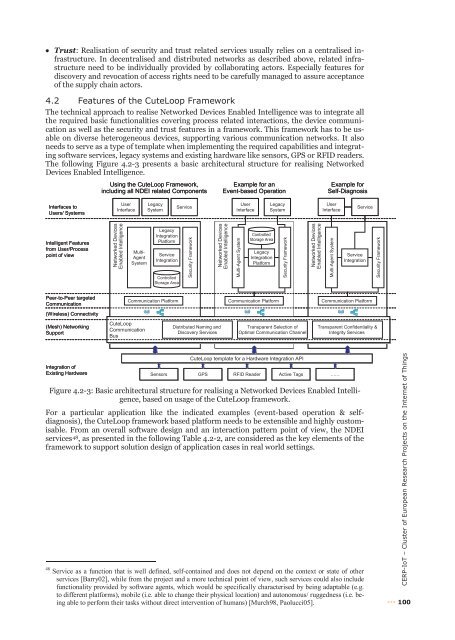Vision and Challenges for Realising the Internet of Things
Vision and Challenges for Realising the Internet of Things
Vision and Challenges for Realising the Internet of Things
Create successful ePaper yourself
Turn your PDF publications into a flip-book with our unique Google optimized e-Paper software.
Trust: Realisation <strong>of</strong> security <strong>and</strong> trust related services usually relies on a centralised infrastructure.<br />
In decentralised <strong>and</strong> distributed networks as described above, related infrastructure<br />
need to be individually provided by collaborating actors. Especially features <strong>for</strong><br />
discovery <strong>and</strong> revocation <strong>of</strong> access rights need to be carefully managed to assure acceptance<br />
<strong>of</strong> <strong>the</strong> supply chain actors.<br />
4.2 Features <strong>of</strong> <strong>the</strong> CuteLoop Framework<br />
The technical approach to realise Networked Devices Enabled Intelligence was to integrate all<br />
<strong>the</strong> required basic functionalities covering process related interactions, <strong>the</strong> device communication<br />
as well as <strong>the</strong> security <strong>and</strong> trust features in a framework. This framework has to be usable<br />
on diverse heterogeneous devices, supporting various communication networks. It also<br />
needs to serve as a type <strong>of</strong> template when implementing <strong>the</strong> required capabilities <strong>and</strong> integrating<br />
s<strong>of</strong>tware services, legacy systems <strong>and</strong> existing hardware like sensors, GPS or RFID readers.<br />
The following Figure 4.2-3 presents a basic architectural structure <strong>for</strong> realising Networked<br />
Devices Enabled Intelligence.<br />
Interfaces to<br />
Users/ Systems<br />
Intelligent Features<br />
from User/Process<br />
point <strong>of</strong> view<br />
Peer-to-Peer targeted<br />
Communication<br />
(Wireless) Connectivity<br />
(Mesh) Networking<br />
Support<br />
Integration <strong>of</strong><br />
Existing Hardware<br />
Using <strong>the</strong> CuteLoop Framework,<br />
including all NDEI related Components<br />
User<br />
Interface<br />
Networked Networked Devices<br />
Devices<br />
Enabled Enabled Intelligence<br />
Intelligence<br />
Multi-<br />
Agent<br />
System<br />
Legacy<br />
System<br />
Networked Networked Devices<br />
Devices<br />
Enabled Enabled Intelligence<br />
Intelligence<br />
Example <strong>for</strong> an<br />
Event-based Operation<br />
Networked Networked Devices<br />
Devices<br />
Enabled Enabled Intelligence<br />
Intelligence<br />
Sensors Sensors<br />
GPS GPS<br />
RFID RFID Reader Reader Active Active Tags Tags<br />
……<br />
……<br />
Example <strong>for</strong><br />
Self-Diagnosis<br />
Communication Plat<strong>for</strong>m Communication Plat<strong>for</strong>m Communication Plat<strong>for</strong>m<br />
CuteLoop<br />
CuteLoop<br />
Communication<br />
Communication<br />
Bus<br />
Bus<br />
Legacy<br />
Integration<br />
Plat<strong>for</strong>m<br />
Service<br />
Integration<br />
Controlled<br />
Storage Area<br />
Service<br />
Security Framework<br />
Distributed Naming <strong>and</strong><br />
Discovery Services<br />
User<br />
Interface<br />
Multi-Agent System<br />
Controlled<br />
Storage Area<br />
Legacy<br />
Integration<br />
Plat<strong>for</strong>m<br />
Legacy<br />
System<br />
Security Framework<br />
Transparent Selection <strong>of</strong><br />
Optimal Communication Channel<br />
CuteLoop CuteLoop template template <strong>for</strong> <strong>for</strong> a a Hardware Hardware Integration Integration API<br />
API<br />
User<br />
Interface<br />
Multi-Agent System<br />
Service<br />
Service<br />
Integration<br />
Security Framework<br />
Transparent Confidentiality &<br />
Integrity Services<br />
Figure 4.2-3: Basic architectural structure <strong>for</strong> realising a Networked Devices Enabled Intelligence,<br />
based on usage <strong>of</strong> <strong>the</strong> CuteLoop framework.<br />
For a particular application like <strong>the</strong> indicated examples (event-based operation & selfdiagnosis),<br />
<strong>the</strong> CuteLoop framework based plat<strong>for</strong>m needs to be extensible <strong>and</strong> highly customisable.<br />
From an overall s<strong>of</strong>tware design <strong>and</strong> an interaction pattern point <strong>of</strong> view, <strong>the</strong> NDEI<br />
services48, as presented in <strong>the</strong> following Table 4.2-2,<br />
are considered as <strong>the</strong> key elements <strong>of</strong> <strong>the</strong><br />
framework to support solution design <strong>of</strong> application cases in real world settings.<br />
48 Service as a function that is well defined, self-contained <strong>and</strong> does not depend on <strong>the</strong> context or state <strong>of</strong> o<strong>the</strong>r<br />
services [Barry02], while from <strong>the</strong> project <strong>and</strong> a more technical point <strong>of</strong> view, such services could also include<br />
functionality provided by s<strong>of</strong>tware agents, which would be specifically characterised by being adaptable (e.g.<br />
to different plat<strong>for</strong>ms), mobile (i.e. able to change <strong>the</strong>ir physical location) <strong>and</strong> autonomous/ ruggedness (i.e. being<br />
able to per<strong>for</strong>m <strong>the</strong>ir tasks without direct intervention <strong>of</strong> humans) [Murch98, Paolucci05].<br />
CERP-IoT – Cluster <strong>of</strong> European Research Projects on <strong>the</strong> <strong>Internet</strong> <strong>of</strong> <strong>Things</strong><br />
100
















